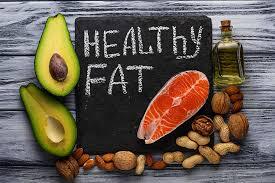
The unending cravings of almost every age group in modern times have hauled us to absorb junk food like sponge, however DO NOT fool yourself by relying on such eatables for being healthy! Fast food would take you nowhere near to good health. Fast food serves as cargo of bad fat also known as trans fats. A proper know how of good dietary fat is imperative to the maintenance of good physical condition. Good fat is referred as unsaturated fat obtained from animal sources as well as some specific plant based fats rich in Omega-3 fatty acids. These are used in body for energy, absorption of lipid soluble vitamins and minerals, bile salt synthesis, cell signaling and transduction.
Beneficial effects of fats in body
Fats, in excess, are a direct threat to major organs of the body such as heart and brain for causing atherosclerosis and stroke. However, fats have a lot of benefits in providing its protective function in these organs as well as in lungs. Apart from the regular functions of fats being responsible for increasing adiposity and adding to body weight, they also have a role in fetal development and normal breathing. Let’s dive deeper into the actual contribution of fatty acids in these domains.
Lower risk of heart diseases
Monounsaturated and polyunsaturated fats increase the levels of healthy cholesterol (HDL cholesterol) along with lowering the bad cholesterol levels (LDL cholesterol) in the body. LDL cholesterol in excess can cause clogging of vessels due to its soft, waxy constitution. Unsaturated fatty acids upregulate LDL receptors to lower the serum triglyceride levels thus reducing the risk of heart diseases. Vegetable oils (olive oil), nuts (almonds, peanuts, cashews) and oily fish etc. are rich in Omega-3 fatty acids and therefore perform the cholesterol lowering function effectively. Plasmalogen form of lipids in heart muscle are more resistant to oxidative stress and hence provide protection to tissues with active aerobic metabolism such as heart and nervous tissue.

Immune function of fats
Lauric acid and myristic acid are two fatty acids that have anti-viral and anti-fungal properties and thus support the immune system by fighting off infectious agents. Prostaglandins through inhibition of its nuclear factor- kappaB (NF-kappaB) have the anti inflammatory effect and may also resolve inflammation after initiation. The antioxidant effect of Omega-3s also have a protective function against cancer progression and metastasis.

Reproductive benefits
Availability of fats is critical to both the synthesis as well as regulation of all the sex hormones which are steroid (lipid) in nature. Sexual maturation demands the presence of these hormones in the body. People who rely on carb diet only for nutrition have a shortfall of these hormones. Malnutrition is thus also a cause of infertility in both males and females, causing complications. Also, the developing embryo during pregnancy utilizes fatty acids for growth and development of its vital organs.
Two important Omega-3 fatty acids are Eicosapentaenoic acid (EPA) and Docosahexaenoic acid (DHA). These are especially abundant in fish oil, krill oil, flax and chia seeds etc. They have special roles in the development of retina and brain of fetus. Sphingolipids are the most abundant membrane lipids in nerve tissue. In addition, they are antigenic in nature serving as a source of blood group, embryonic and some tumor antigens etc. This property plays a major role in growth and development. Dietary sources of sphingolipids include dairy products, soybeans and eggs.

Muscle mass acquisition
Healthy fat intake along with proper exercise helps gain muscle mass as it promotes hormone balance. With high fat and carb restriction, the levels of growth hormone increases that prevent muscle breakdown. Growth hormone triggers protein formation thus maintaining muscle tissue. People with high body fat have more spare energy and thus are more prone of gaining muscles with training.

Ventilatory function as component of lung surfactant
The phospholipid “dipalmitoyl phosphatidylcholine” or DPPC is the vital component of lung surfactant along with some proteins and carbohydrate. The surfactant serves the purposes of narrowing the surface tension that would otherwise cause the alveoli to collapse. The adherence of inner surfaces of lungs at the air water interface is prevented by this surface active agent. Minimization of the effort needed to re-inflate the alveoli after expiration greatly reduces the work of breathing. Artificial surfactant through intra tracheal instillation have also been used to make the survival of fetus possible. This typically occurs in case of preterm birth when the amount of surfactant is not sufficient to aid breathing. Asthma relieving drugs also have a contribution of fats in the form of leukotrienes.

Natural sources of fat
- Fruits: avocados
- Nuts: almonds, cashews, and, hazelnuts, walnuts
- Seeds: pumpkin seeds, sesame seeds, sunflower seeds, flaxseeds, sunflower seeds
- Plant oils: olive, sesame, peanut, safflower, and canola oils
- Fish: salmon, mackerel, herring, tuna, and trout

Recommended daily allowance
An average adult requires only 20g/day. The requirement increases to about 30-45g/day for pregnant and lactating women. Children of growing age must take about 22-25g/day. The concentration of saturated fatty acids should be under control as these are mainly responsible for healthy hazards. Also, a healthy fat may also become unhealthy if exposed to unusual heat, oxidation, moisture causing it to become rancid. Furthermore, some preservatives for making foods ‘shelf-stable’ can also turn fats rancid.
Fats as a health hazard
Fatty acids as components of membranes maintain the water permeability barrier thus supporting skin, hair and nail texture. They also regulate blood sugar level and helps lower blood pressure in hypertensives. Regulation of healthy metabolism and prevention of hanger pangs are also the vital functions of fats. However, as stated,
“Too much of anything is bad” — Mark Twain.
excess of fats can also lead to serious health conditions such as CVDs (mainly heart disease and stroke), musculoskeletal disorders like osteoarthritis, type 2 diabetes and cancers (endometrial, breast and colon).
Disclaimer: This article serves the sole purpose of providing knowledge. Any relatable condition or symptom must be consulted by a physician for proper diagnosis before opting medication.